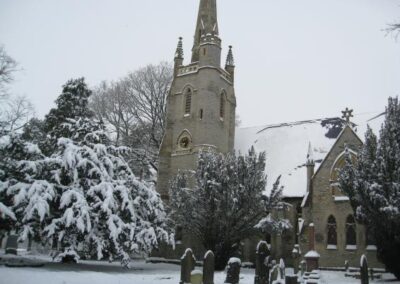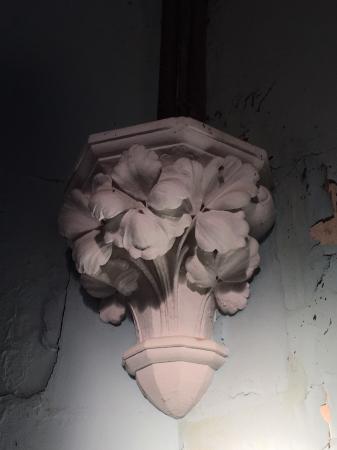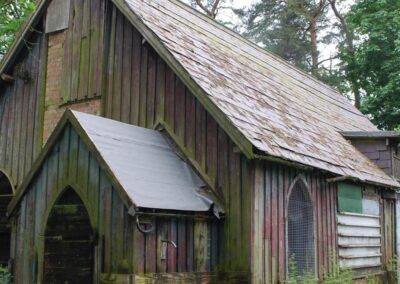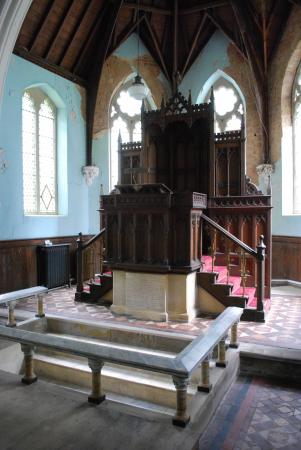Umberslade Baptist Church
A wealthy industrialist’s estate chapel with an unusual twist. It was built by George Frederick Muntz following his purchase of Umberslade Park. Muntz was a Baptist convert and placed the church between his house and the village to attract further converts to the Baptist cause.
Directions
There is parking at the foot of the access track from Spring Lane to the chapel. There is a large sign to show the entrance. Unless prior arrangements have been made please park by the locked gate and walk to the chapel. Three public footpaths pass through the burial ground and by the church. The nearest bus services are in Hockley Heath (half a mile) and the nearest train station is Dorridge.
In the area
Packwood House is an Elizabethan Mansion with extensive gardens and famous topiary, just 2 mils from the Church.
The Millennium Way Long Distance Path passes within one mile of the church and footpaths allow a diversion via the church and its burial ground – and a tall obelisk, part of the park landscaping.
Address
Spring Lane
Hockley Heath
Nr. Solihull
B94 6QY
United Kingdom
The chapel is normally locked. For Open Days or to arrange a group visit go to the Umberslade facebook page.
Umberslade Baptist Church (originally called Christ Church Umbersalde) dates from 1877. It is now the sole survivor among several chapels associated with the rise of Birmingham Nonconformity. Umberslade was founded and paid for by George Frederick Muntz, a successful industrialist of German origin, and a zealous Baptist convert. Having become owner of Umberslade Hall, the church was an estate church. Sadly, today the M40 motorway separates the Hall from the chapel. The nearby tall obelisk was also conceived as a park monument.
Umberslade Baptist Church is the last surviving major chapel of the Birmingham architect, George Ingall (1868–1910). Ingall deployed the Decorated Gothic style, enriching the church with pinnacles, finials, buttresses, and a slender tower and spire, in winter visible from the motorway. The church is constructed in a grey freestone. Inside, the timber furnishings are largely intact and include a large Gothic central pulpit. In front of it is an open baptistry for total immersion baptisms, finished in marble.
Many of the benches retain their gas lamps. The stained glass is geometric and the memorial to the founder inside the church is is cast in ‘Muntz metal’, an alloy G. F. Muntz patented to great commercial success as it repelled barnacles and weed and was used to clad the wooden hulls of tea clippers and merchant ships. When restored in recent years the hull of the most famous tea clipper of them all, the Cutty Sark, was again covered in Muntz metal as it was in the vessel’s heyday. G F Muntz’s grave is in the burial ground.
Nearby is the wooden building used as the temporary church while the stone one was being built and later as a school room until well into the twentieth century. This too is now listed as is the war memorial in the burial ground.
When elderly and bed-ridden G F Muntz had a landline installed so that he could listen to services in the church by loudspeaker in his bedroom at the Hall.
Historic Chapels Trust acquired the building after a long period of neglect once the Baptists had left. The first phase of restoration was achieved with generous support of Historic England and the Heritage Lottery Fund.
This secured the most crumbled stonework and saw the leaking roof completely re-slated. There is much yet to do, however. The schoolroom in the detached wooden building and vestry and committee rooms at the end of the church need extensive repair.
An active band of volunteers, the Friends of Umberslade Baptist Church, maintain the large burial ground and open the church to the public regularly. For details of their working parties and for more on the history of this site visit their facebook page.
The chapel does not yet have facilities so is not available for hire.
Burial plots are available at Umberslade.








